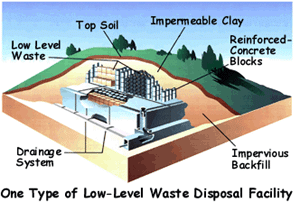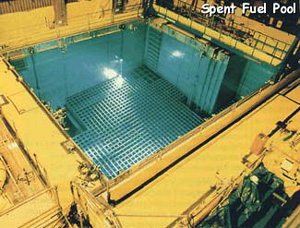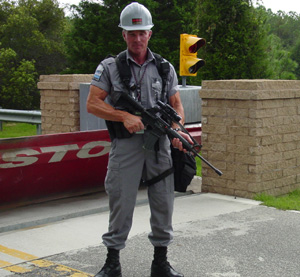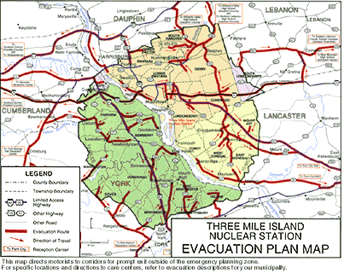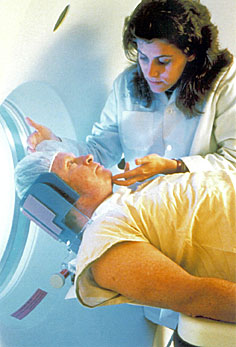It also releases energy in the form of heat. The released neutrons can then repeat the process. This releases even more neutrons and more nuclear energy. The repeating of the process is called a chain reaction. In a nuclear power plant, uranium is the material used in the fission process. The heat from fission boils water and creates steam to turn a turbine. As the turbine spins, the generator turns and its magnetic field produces electricity. The electricity can then be carried to your home, so you can work on the computer, watch television, play video games, or make toast! The U.S. Nuclear Regulatory Commission, also called the “NRC,” regulates nuclear power plants. We make sure they are safe for people who work there and live nearby, and for the environment. The NRC also regulates nuclear material that is used in science, medicine and industry. We issue licenses to those who operate power plants or use nuclear material, and we inspect them to make sure they’re following our rules. Nuclear material is used for many things besides nuclear power: To detect and treat certain illnesses To perform research at universities To help in industries for such things as locating cracks in steel, getting rid of dust from film and even measuring the amount of air whipped into ice cream! Source: http://www.nrc.gov/reading-rm/basic-ref/students.html
Nuclear power plants generate two types of waste: high-level and low-level. High-level waste includes the fuel that was used in the nuclear reactor, called “spent fuel.” It is highly radioactive and very dangerous. It must be cooled for several years in deep pools inside the plant, after which it can be transferred to special casks, which are like big, concrete barrels. Some of the fission products in the spent fuel will take many years to lose their radioactivity. A special disposal site is needed for this type of waste. In early 2012, a Blue Ribbon Commission of policy experts recommended creating one or more large facilities where the waste from several nuclear plants can be stored until a disposal site is found. Low-level waste can come from nuclear reactors or from hospitals or universities. Low-level waste is not as dangerous as high-level waste. It can be shipped to low-level waste disposal facilities. There, it is packaged, buried in trenches and covered with soil. States are responsible for selecting new disposal sites or using those that already exist. Nuclear power provides about 20 percent of our nation’s electricity. And nuclear materials help in thousands of medical procedures and dozens of industrial uses. But many scientists believe we haven’t yet found all the ways to use nuclear materials. The NRC will be closely regulating any peaceful use of nuclear material to protect public health and safety, and the world in which we live. Source: http://www.nrc.gov/reading-rm/basic-ref/students.html
Nuclear power plants are licensed by the NRC for 40 years. After that, they can ask to renew their license, or they can shut down the plant and decommission it. Decommissioning means shutting down the plant and taking steps to reduce the level of radiation so that the land can be used for other things. NRC has very strict rules for shutting down a plant. The NRC requires plants to finish the process within 60 years of closing. Since it may cost $300 million or more to shut down and decommission a plant, the NRC requires plant owners to set aside money when the plant is still operating to pay for the future shutdown costs. Nuclear power plants can be decommissioned using three methods: Dismantling — Parts of the reactor are removed or decontaminated soon after the plant closes and the land can be used. Safe Storage — The nuclear plant is monitored and radiation is allowed to decay; afterward, it is taken down. Entombment — Radioactive components are sealed off with concrete and steel, allowing radiation to “decay” until the land can be used for other purposes. Source: http://www.nrc.gov/reading-rm/basic-ref/students.html
Nuclear power plants have always had armed guards and other measures to protect the facility from people who didn’t belong there. After the terrorist attacks of Sept. 11, 2001, even more security measures were put in place. These measures are very strict because protecting the plant from sabotage or attack is important to protect people and the environment. Source: http://www.nrc.gov/reading-rm/basic-ref/students.html
All owners of nuclear power plants must have emergency plans. These plans allow workers and people who live near the plants to know how to handle emergencies. Federal, state and local governments work together in case people need to be evacuated or other actions taken to protect local residents. All nuclear power plants practice regular drills (think a really important fire drill at your school) on a regular basis. These drills simulate a serious accident to test the emergency plan. Since the Three Mile Island accident, many changes have made nuclear power plants safer. Reactor operators are trained to handle emergencies using computer simulators. The NRC emergency operations center is open 24 hours a day every day so we are always ready if something happens. The NRC has inspectors at each plant and collects more information from the owners of plants so we can make the right safety decisions. Source: http://www.nrc.gov/reading-rm/basic-ref/students.html
Radiation is naturally present in our environment, but it can also be produced artificially, as a byproduct of the process of creating energy by splitting atoms. This is how nuclear reactors create radioactive materials (known as “byproduct materials”) that can be used to benefit humankind in a surprising number of ways, as described on this page: Industrial Uses Medical and Veterinary Uses Academic and Scientific Applications Industrial Uses We could talk all day about the many surprising industrial uses of radiation and not complete the list, but a few examples illustrate the point: Irradiators sterilize medical equipment and donated blood by exposing them to radiation to kill germs and help prevent the spread of disease. Some foods, spices, and drink containers are also sterilized this way so that they stay fresh longer. In an irradiator, the radioactive material, or “source,” emits a beam of radiation that is powerful enough to kill any harmful germs. The beam does not make the items themselves radioactive, however, so they are safe to use — in fact, safer than they were before being treated. Gauges use radioactive material to measure moisture in soil during construction of roads and buildings. They also measure and control the thickness of products such as paper napkins, newspapers, plastics and sheet metals.The radioactive material in gauges can also measure the amount of air whipped into our ice cream. In addition, they can control how fast a liquid flows into a container, and make sure that every bottle is filled to the same level. That’s how you know that when you buy a liter of your favorite drink, you really are getting a liter. Radiography cameras use radioactive materials to produce an image on photographic film to show the condition of the insides of pipes or walls. This allows engineers to detect defects without actually damaging or destroying the object being scanned. The image resembles an x-ray you might have taken at your doctor’s office. Well logging devices use radioactive materials and detectors to help in exploring for oil, natural gas, or minerals. These devices are inserted into deep wells and help create a map of the resources underground. Smoke detectors use radioactive material to ionize the air around them and trigger an alarm if smoke is present. Even the small smoke detectors in your home may contain a tiny amount of radioactive material that helps protect you and your family. Medical and Veterinary Uses Hospitals, doctors, dentists, and even veterinarians use radioactive materials to help diagnose, treat, and study illnesses such as cancer. In fact, thousands of patients are treated each year with radioactive materials in the United States. Diagnostic Uses If you’ve ever had a CT scan or PET scan, you were probably asked to drink a liquid and sit or lie under — or inside — a big machine. The liquid contained a small amount of radioactive material and, while it traveled through your body, the machine was able to take pictures of your internal organs so your doctor could see if they were working properly. These color pictures show the shapes and details of your internal organs. This helps your doctor locate and identify tumors or other problems with internal organs. Hospitals and radiology centers also perform approximately 10 million “nuclear medicine” procedures in the United States each year. In such procedures, doctors diagnose patients’ medical problems using slightly radioactive substances, which are attracted to certain internal organs, such as the pancreas, kidney, thyroid, liver, or brain. Sometimes, instead of asking you to sit under a machine after drinking the radioactive liquid, your doctor may test your urine to see how well your body was able to flush out the radiation. Therapeutic Uses Radioactive materials can also be used to actively fight a disease, kill cancerous tissue, reduce the size of a tumor, or reduce pain. Tiny radioactive seeds can be implanted in a patient’s body to kill a cancerous tumor. Radioactive material can be swallowed, or powerful beams of radiation can be used to shrink tumors. Therapeutic doses may also be used to treat other conditions, such as clogged blood vessels. In addition, radioactive material can act like a pain pill, to make a patient more comfortable. Medical Research When nuclear materials are used in humans as part of a medical research study, this usually involves testing a new drug or medical device to see how safe and effective it will be. This type of research can also be used to determine how different patients respond to treatment with radioactive materials. Veterinary Uses As with people, radioactive materials can be used to diagnose, treat, and study illnesses in domestic pets and non-food animals. At the present time, no radioactive veterinary drugs have been approved for use in animals intended for the human food supply. Academic and Scientific Applications Some universities and colleges, high schools, and other academic and scientific institutions use radioactive materials in laboratory experiments and research, as well as classroom demonstrations. In fact, if you’ve ever conducted a gas chromatography experiment in chemistry lab, you’ve used a device that contains radioactive material! Archaeologists also use radioactive materials to determine the ages of fossils and other objects through a process called “carbon dating.” In addition, radioactive materials power our dreams of outer space, as they fuel our spacecraft and supply electricity to satellites that are sent on missions to the outermost regions of our solar system. Source: http://www.nrc.gov/reading-rm/basic-ref/students.html
In Reactors, Radiation Is Trapped and Contained in Several Ways: Small amounts of radioactivity can be released into the environment but only under controlled and monitored conditions. The only major accident in a nuclear power plant in this country was at Three Mile Island near Harrisburg, Pennsylvania, in March 1979. At Three Mile Island, there was major fuel damage, and radioactive gases and contaminated cooling water filled the containment building. Some radioactivity was released into the atmosphere, but it didn’t hurt people or the environment. A much more serious accident happened in 1986 at Chernobyl in the former Soviet Union. That reactor was built differently than those in the U.S. Most importantly, it had no containment system. The reactor core was severely damaged and a large amount of radioactivity was released into the environment.
There are two types of reactors on the world that are most used: The Pressurized Water Reactor (PWR) Pressurized Water Reactors are known as “PWR”‘s. They keep water under pressure so that it heats but does not boil. Water from the reactor and the water that is turned into steam are in separate pipes and never mix. And the Boiling Water Reactor (BWR) Boiling Water Reactors are known as “BWR”s. In BWRs, the water heated by fission actually boils and turns into steam to turn the generator. In both types of plants, the steam is turned back into water and can be used again in the process. Radioactivity must be carefully managed because it can be dangerous if not handled properly. It can damage human cells or cause cancer over time. Since the fission process creates radioactivity, all nuclear power plants have many safety systems that protect workers, the public and the environment. For example, systems allow the fission process to be stopped and the reactor to be shut down quickly. Other systems cool the reactor and carry heat away from it. Barriers keep the radioactivity from escaping into the environment. In reactors, radioactive material is contained inside small ceramic pellets about the size of an adult’s finger. They are placed in long metal rods inside a reactor vessel, which is enclosed in a concrete and steel containment building. These buildings have walls three to six feet thick! Source: http://www.nrc.gov/reading-rm/basic-ref/students.html


